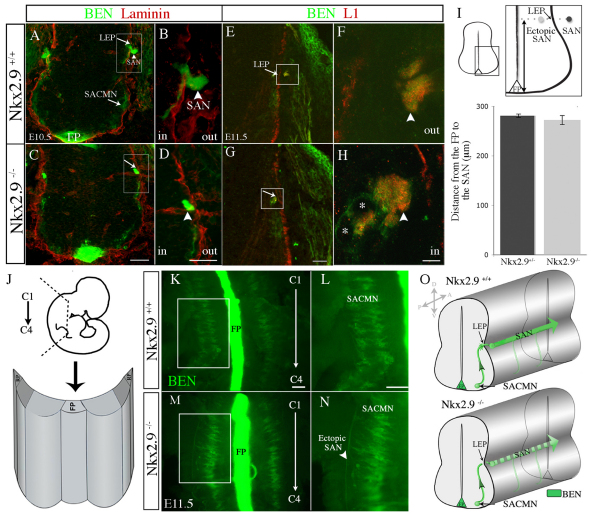Fig. 1.
In Nkx2.9–/– embryos, SACMN axons fail to exit the CNS and assemble into an ectopic SAN within the spinal cord. (A-H) Wild-type (WT) (A,B, E10.5; E,F, E11.5) and Nkx2.9–/– (C,D, E10.5; G,H, E11.5) embryos were labeled with either anti-BEN and anti-laminin (A-D) or anti-BEN and anti-L1 (E-H). (A,B) In E10.5 WT embryos, BEN-labeled spinal accessory motor neuron (SACMN) axons extend through the lateral exit point (LEP) and assemble into a spinal accessory nerve (SAN) located outside the CNS. (C,D) SACMN axons appropriately extend to the LEP in Nkx2.9–/– mice but fail to exit and remain within the anti-laminin-labeled margin of the spinal cord (arrow), where they appear to assemble into an ectopic SAN (arrowhead) (n>5). B and D are magnified views of the boxed areas in A and C, respectively. (E-H) A BEN/L1-expressing SAN (arrowhead) forms outside of the spinal cord and adjacent to the LEP (arrow) in WT embryos, whereas in Nkx2.9–/– mice the SAN inappropriately forms within the spinal cord adjacent to the LEP and BEN-expressing SACMN (H, asterisks). F and H are magnified views of the boxed areas in E and G, respectively. (I) The distance from the base of the floor plate (FP) to the SAN (see upper schematic) was not statistically different in WT (dark gray; SAN) as compared with Nkx2.9–/– (light gray; ectopic SAN) embryos (n=4). Error bars indicate s.d. (J) Schematized open-book (OB) preparation from cervical levels (C1-C4) of the spinal cord. RP, roof plate. (K-N) OB preparations derived from an E11.5 Nkx2.9 null embryo and a WT littermate labeled with anti-BEN. In contrast to WT embryos (K,L), an ectopic SAN is located within the spinal cord of Nkx2.9–/– embryos (M,N; n=3). L and N are magnified views of the boxed areas in K and M, respectively. (O) The trajectory of SACMN axons in WT and Nkx2.9–/– embryos. Scale bars: 50 μm in C for A,C; 25 μm in D for B,D; 100 μm in G for E,G, in K for K,M, in L for L,N; 5 μm in H for F,H.

